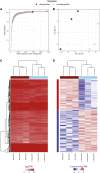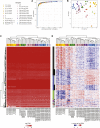A Meta-Analysis of Wolbachia Transcriptomics Reveals a Stage-Specific Wolbachia Transcriptional Response Shared Across Different Hosts
- PMID: 32718933
- PMCID: PMC7467002
- DOI: 10.1534/g3.120.401534
A Meta-Analysis of Wolbachia Transcriptomics Reveals a Stage-Specific Wolbachia Transcriptional Response Shared Across Different Hosts
Abstract
Wolbachia is a genus containing obligate, intracellular endosymbionts with arthropod and nematode hosts. Numerous studies have identified differentially expressed transcripts in Wolbachia endosymbionts that potentially inform the biological interplay between these endosymbionts and their hosts, albeit with discordant results. Here, we re-analyze previously published Wolbachia RNA-Seq transcriptomics data sets using a single workflow consisting of the most up-to-date algorithms and techniques, with the aim of identifying trends or patterns in the pan-Wolbachia transcriptional response. We find that data from one of the early studies in filarial nematodes did not allow for robust conclusions about Wolbachia differential expression with these methods, suggesting the original interpretations should be reconsidered. Across datasets analyzed with this unified workflow, there is a general lack of global gene regulation with the exception of a weak transcriptional response resulting in the upregulation of ribosomal proteins in early larval stages. This weak response is observed across diverse Wolbachia strains from both nematode and insect hosts suggesting a potential pan-Wolbachia transcriptional response during host development that diverged more than 700 million years ago.
Keywords: RNA-Seq; Wolbachia; bacteria; intracellular; meta-analysis; transcriptomics.
Copyright © 2020 Chung et al.
Figures









References
Publication types
MeSH terms
Grants and funding
LinkOut - more resources
Full Text Sources
